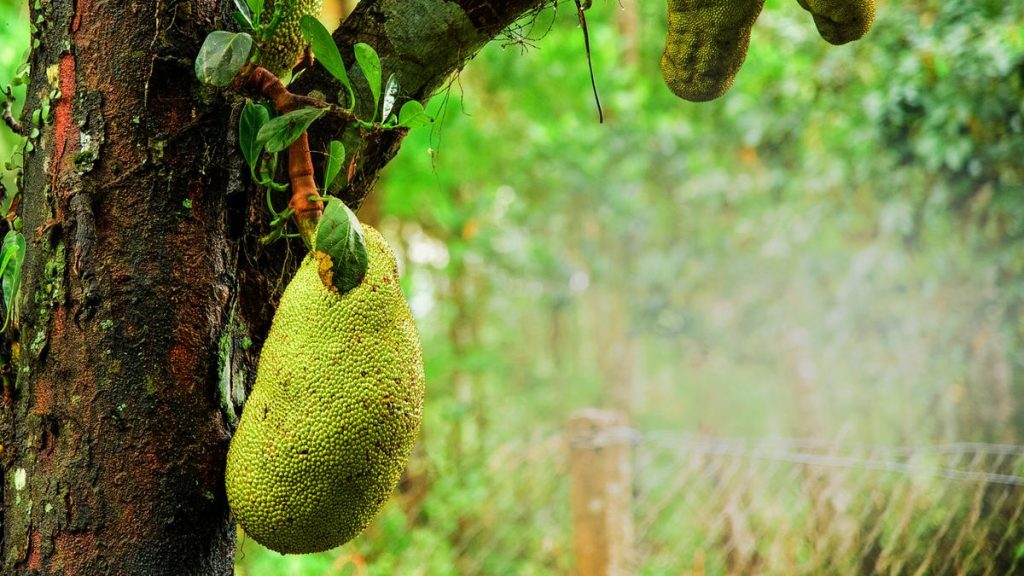डॉ. डी. बालसुब्रमण्यन

यदि आम (Mango) को फलों का राजा कहा जाता है, तो कटहल (Jackfruit) को सभी फलों में डॉक्टर कहा जा सकता है। भारत और मध्य-पूर्व के लोग कटहल (Artocarpus heterophyllus) से बहुत पहले से परिचित हैं। कटहल का उपयोग आयुर्वेद (Ayurveda) और यूनानी चिकित्सा (Unani medicine) पद्धति में स्वास्थ्यवर्धक के रूप में किया जाता रहा है। तमिल में ‘पला’, बंगाली में ‘कंटहल’ और मलयालम में ‘चक्का’ कहलाने वाला कटहल (Jackfruit in India) भारत के दक्षिणी (Southern India) और पूर्वोत्तर राज्यों (Northeast India) में अधिकतर भोजन का हिस्सा है, जबकि अन्य क्षेत्रों में यह फल (fruit) की तरह अधिक खाया जाता है। मलेशिया (Malaysia) जैसे दक्षिण-पूर्वी एशियाई (Southeast Asian countries) देशों में यह प्रचुर मात्रा में पाया जाता है, और यहां से इसे मध्य पूर्व (Middle East) क्षेत्रों में निर्यात किया जाता है।
कटहल का पेड़ (Jackfruit tree) विशाल (और घना) होता है। इसके फल पेड़ की पतली शाखाओं (tree branches) पर नहीं लगते बल्कि तने (trunk) और मोटी शाखाओं के जोड़ के आसपास लगते हैं। यहां लगने से इसे बहुत बड़े आकार में बढ़ने में मदद मिलती है; केरल (Kerala) में 42 किलोग्राम (42 kg jackfruit) का एक कटहल अब तक एक रिकॉर्ड है। कटहल का पका हुआ फल (Ripe Jackfruit) मीठा और स्वादिष्ट होता है। और कच्चे कटहल (Raw Jackfruit) से कई तरह के व्यंजन बनते हैं। इसे मांस के विकल्प (meat alternative) के रूप में भी इस्तेमाल किया जाता है, क्योंकि इसमें वसा (low fat) और कोलेस्ट्रॉल (low cholesterol) कम होता है और इसका स्वाद मांस जितना अच्छा (meaty texture) होता है! कटहल बिरयानी (Jackfruit Biryani) भी एक स्वादिष्ट शाकाहारी विकल्प (vegetarian alternative) है।
इस पेड़ के कई अन्य उपयोग भी हैं। दक्षिण-पूर्व एशियाई (Southeast Asian) भिक्षु कटहल की छाल (Jackfruit tree bark) से रंगे हुए वस्त्र पहनते हैं; यह वस्त्रों को धूपिया पीला रंग (saffron-colored dye) देते हैं – कुछ-कुछ शहद के रंग (honey-colored fabric) जैसा। कटहल का यह रंग इसकी लकड़ी (Jackfruit wood) से बने फर्नीचर (furniture) को भी एक अच्छी रंगत देता है। इसकी लकड़ी मज़बूत (strong wood) और दीमक प्रतिरोधी (termite-resistant) होती है।
सुपरफूड कटहल
इन सभी खूबियों के साथ-साथ, कटहल एक सुपरफूड (superfood) के रूप में विश्वभर में लोकप्रिय हो रहा है। क्लीवलैंड युनिवर्सिटी (Cleveland University) की एक व्यापक समीक्षा बताती है कि कटहल प्रोटीन (protein), विटामिन (vitamin), खनिज (minerals) और पादप रसायनों (phytonutrients), के अलावा पोटेशियम (potassium), मैग्नीशियम (magnesium) और फॉस्फोरस (phosphorus) जैसे तत्वों से भरपूर है। ड्यूक युनिवर्सिटी (Duke University) की वेबसाइट पर वैज्ञानिक ब्रायना इलियट (Brianna Elliott) ने कटहल के पोषण सम्बंधी लाभों पर प्रकाश डाला है। वे बताती हैं कि पोषण की दृष्टि से कटहल की फांकें सेब और आम (better in nutrition than apple and mango) की तुलना में बेहतर हैं। कई संदर्भों का हवाला देते हुए वे बताती हैं कि कटहल का फल रक्त शर्करा के स्तर (blood sugar level) को नियंत्रित करता है; यकृत (liver) से लेकर अन्य अंगों में जमा वसा को घटाता (fat reduction) है; और इसमें मौजूद कैरोटीनॉइड्स (carotenoids) टाइप-2 डायबिटीज़ (Type-2 Diabetes) और हृदय रोगों (heart diseases) के जोखिम को कम करते हैं। इसमें मौजूद विटामिन ‘ए’ और ‘सी’ वायरल संक्रमण के जोखिम को कम करते हैं।
WebMed वेबसाइट भी इसके कई लाभ बताती है। इसके अनुसार, “कटहल ज़रूरी विटामिनों और खनिज से सराबोर है, विशेष रूप से यह विटामिन ‘बी’ (Vitamin B complex), पोटेशियम (potassium) और विटामिन ‘सी’ (Vitamin C) का एक अच्छा स्रोत है।” कटहल मधुमेह के रोगियों के लिए विशेष रूप से उपयोगी है। भारत में लगभग 21.5 करोड़ लोग मधुमेह (diabetes in india) से पीड़ित हैं। 2021 में, आंध्र प्रदेश (Andra Pradesh) के श्रीकाकुलम (Srikakulam) स्थित गवर्नमेंट मेडिकल कॉलेज के ए. गोपाल राव (A. Gopal Rao) और उनके साथियों ने न्यूट्रिशन एंड डायबिटीज़ जर्नल (Nutrition and diabetes journal) में एक रैंडम क्लीनिकल परीक्षण (random clinical trial) के नतीजे प्रकाशित किए हैं। इसमें बताया गया है कि कच्चे कटहल का आटा (Raw Jackfruit Flour) (जिसे कच्चे कटहल के गूदेदार हिस्से (raw jackfruit pulp) को सुखाकर, पीसकर बनाया जाता है) ग्लाइसेमिक नियंत्रण (glycemic control) में कुशल है और चावल (rice) या गेहूं (wheat) जैसे मुख्य आहार का विकल्प बन सकता है। कटहल का आटे के रूप में इस्तेमाल उत्तरी राज्यों में विशेष रूप से उपयोगी हो सकता है जहां कटहल की खेती नहीं होती। इस शोधपत्र के एक लेखक जेम्स जोसेफ एक कंपनी (jackfruit 365) चलाते हैं जो पूरे भारत में कटहल का आटा बेचती है।
कटहल (Jackfruit for health) मधुमेह रोगियों और स्वस्थ लोगों, दोनों के लिए दैनिक आहार का एक वांछनीय हिस्सा है। तो सब्ज़ी (jackfruit curry), अचार (jackfruit pickle), फल (jackfruit fruit) या आटे (jackfruit flour) किसी भी रूप में इसे इस्तेमाल करें और स्वस्थ रहें! (स्रोत फीचर्स)
नोट: स्रोत में छपे लेखों के विचार लेखकों के हैं। एकलव्य का इनसे सहमत होना आवश्यक नहीं है।
Photo Credit : https://th-i.thgim.com/public/incoming/dz9a5k/article69362869.ece/alternates/LANDSCAPE_1200/IMG_30tvmp_chakka_2_1_33DTQT0A.jpg